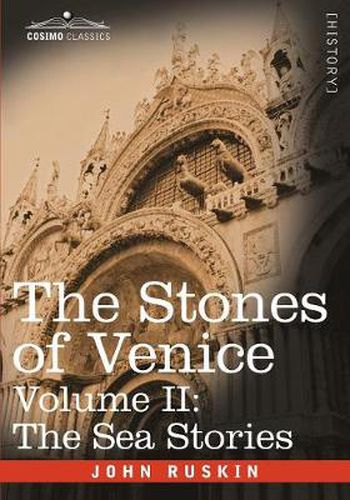Readings Newsletter
Become a Readings Member to make your shopping experience even easier.
Sign in or sign up for free!
You’re not far away from qualifying for FREE standard shipping within Australia
You’ve qualified for FREE standard shipping within Australia
The cart is loading…






This title is printed to order. This book may have been self-published. If so, we cannot guarantee the quality of the content. In the main most books will have gone through the editing process however some may not. We therefore suggest that you be aware of this before ordering this book. If in doubt check either the author or publisher’s details as we are unable to accept any returns unless they are faulty. Please contact us if you have any questions.
More than simply a survey of an ancient city’s most significant buildings, The Stones of Venice?first published in three volumes between 1851 and 1853?is an expression of a philosophy of art, nature, and morality that goes beyond art history, and has inspired such thinkers as Leo Tolstoy, Marcel Proust, and Mahatma Gandhi. Volume II, examining the Byzantine era and the architectural developments of Venice?s Gothic period, includes the oft-anthologized chapter ?The Nature of Gothic, ? one of the author?s most important discussions of his key theme, ?the relation of the art of Venice to her moral temper.? For Ruskin, the Gothic style embodied the same moral truths sought by great art. Informative, aesthetic, and spiritual, this architectural exploration will be appreciated by students and scholars alike. The preeminent art critic of his time, British writer JOHN RUSKIN (1819?1900) had a profound influence upon European painting, architecture, and aesthetics of the 19th and 20th centuries. His immense body of literary works include Modern Painters, Volume I?IV (1843?1856); The Seven Lamps of Architecture (1849); Unto This Last (1862); Munera Pulveris (1862?3); The Crown of Wild Olive (1866); Time and Tide (1867); and Fors Clavigera (1871-84).
$9.00 standard shipping within Australia
FREE standard shipping within Australia for orders over $100.00
Express & International shipping calculated at checkout
This title is printed to order. This book may have been self-published. If so, we cannot guarantee the quality of the content. In the main most books will have gone through the editing process however some may not. We therefore suggest that you be aware of this before ordering this book. If in doubt check either the author or publisher’s details as we are unable to accept any returns unless they are faulty. Please contact us if you have any questions.
More than simply a survey of an ancient city’s most significant buildings, The Stones of Venice?first published in three volumes between 1851 and 1853?is an expression of a philosophy of art, nature, and morality that goes beyond art history, and has inspired such thinkers as Leo Tolstoy, Marcel Proust, and Mahatma Gandhi. Volume II, examining the Byzantine era and the architectural developments of Venice?s Gothic period, includes the oft-anthologized chapter ?The Nature of Gothic, ? one of the author?s most important discussions of his key theme, ?the relation of the art of Venice to her moral temper.? For Ruskin, the Gothic style embodied the same moral truths sought by great art. Informative, aesthetic, and spiritual, this architectural exploration will be appreciated by students and scholars alike. The preeminent art critic of his time, British writer JOHN RUSKIN (1819?1900) had a profound influence upon European painting, architecture, and aesthetics of the 19th and 20th centuries. His immense body of literary works include Modern Painters, Volume I?IV (1843?1856); The Seven Lamps of Architecture (1849); Unto This Last (1862); Munera Pulveris (1862?3); The Crown of Wild Olive (1866); Time and Tide (1867); and Fors Clavigera (1871-84).